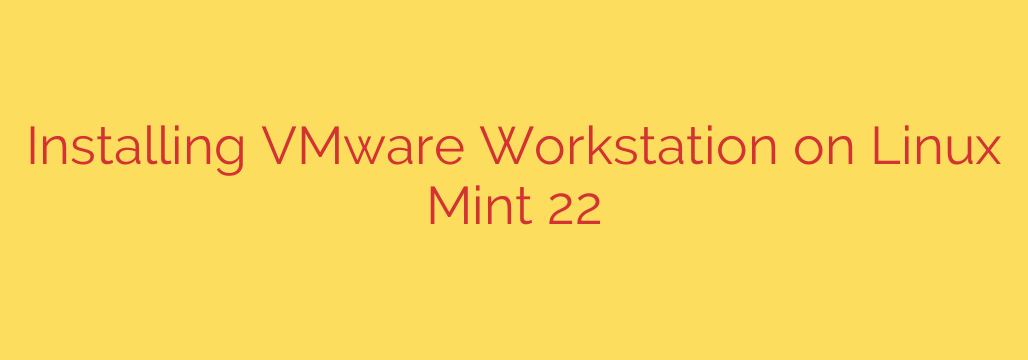
Installing VMware Workstation Pro on your Linux Mint 22 system allows you to run multiple operating systems as virtual machines simultaneously. It’s a powerful tool for developers, testers, and anyone who needs to work with different environments without altering their main system. While the installation process is straightforward, it involves a few crucial steps to ensure everything runs smoothly.
Here’s a comprehensive guide to getting VMware Workstation Pro set up on your Linux Mint 22 machine.
Prerequisites Before You Begin
Before you download and install VMware Workstation, ensure your system meets the basic requirements and has the necessary build tools installed. You will need:
- A compatible 64-bit Linux Mint 22 installation.
- Sufficient disk space for the VMware installation and your virtual machines.
- A stable internet connection to download the installer and dependencies.
- Root or sudo privileges.
You also need to install essential packages required to build the VMware kernel modules. Open your terminal and run the following commands:
sudo apt update
sudo apt install **build-essential** **linux-headers-$(uname -r)**
This command updates your package lists and then installs the build-essential package (which includes the gcc compiler and other tools) and the Linux headers specific to your currently running kernel. The headers are vital for VMware to build modules compatible with your system.
Downloading VMware Workstation Pro
The next step is to download the official VMware Workstation Pro installer. You’ll need to visit the official VMware website’s download section. Locate the latest version of VMware Workstation Pro for Linux and download the .bundle installer file. Save it to a convenient location, such as your Downloads folder.
Making the Installer Executable
The downloaded .bundle file is not executable by default. You need to give it execute permissions. Open your terminal and navigate to the directory where you saved the file using the cd command. For example, if it’s in Downloads:
cd ~/Downloads
Now, make the file executable using the chmod command. Replace VMware-Workstation-Full-*.x86_64.bundle with the actual filename you downloaded:
chmod +x **VMware-Workstation-Full-*.x86_64.bundle**
Running the Installer
With the executable permission set, you can now run the installer with sudo privileges. Execute the following command in the terminal, again replacing the filename as needed:
sudo ./VMware-Workstation-Full-*.x86_64.bundle
The installer will launch a graphical interface. Simply follow the on-screen prompts. You will typically be asked to:
- Accept the End User License Agreement.
- Choose whether to check for updates automatically.
- Decide whether to participate in the VMware Customer Experience Improvement Program.
- Enter a license key if you have one (you can also run it as a trial).
Proceed through the steps. The installer will copy files and build the necessary kernel modules based on the linux-headers you installed earlier. This process might take a few minutes.
Launching VMware Workstation Pro
Once the installation completes successfully, you can close the installer window. VMware Workstation Pro should now be available in your application menu. Search for “VMware Workstation” and launch it.
Upon the first launch, you might be prompted to enter your license key if you didn’t do so during installation.
Post-Installation Notes and Troubleshooting
- Kernel Module Issues: If you encounter errors during installation related to kernel modules, double-check that you installed the correct linux-headers matching your running kernel version (
uname -r). Re-running the install command after installing headers often resolves this. - Updates: When your Linux kernel updates, you may need to re-run the VMware installer (or specific commands provided by VMware) to recompile the kernel modules against the new kernel version. VMware Workstation usually prompts you if this is needed upon launch after a kernel update.
- Open VM Tools: For better integration between your virtual machines (specifically Linux guests) and the VMware host, it is highly recommended to install open-vm-tools inside your guest operating systems. This provides features like shared clipboards, drag-and-drop, and proper screen resizing. You can usually install it via the guest OS’s package manager (e.g.,
sudo apt install **open-vm-tools**on Debian/Ubuntu/Mint guests).
By following these steps, you should have VMware Workstation Pro successfully installed and running on your Linux Mint 22 system, ready to create and manage your virtual machines.
Source: https://linuxways.net/mint/how-to-install-vmware-workstation-on-linux-mint-22/








